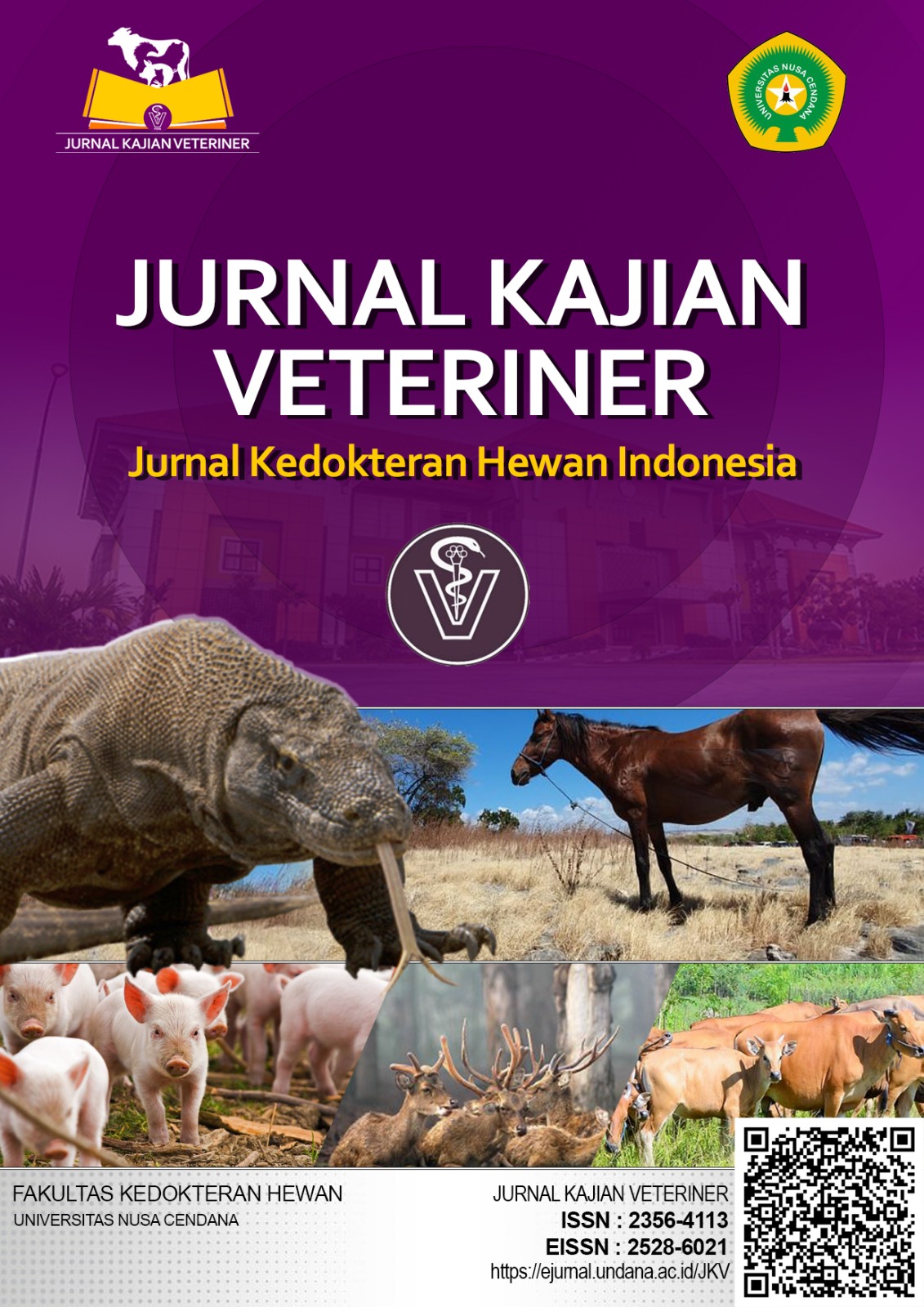Aktivitas Antioksidan dan Antibakteri Ekstrak Etanol Kulit Batang Lunasia amara
Antioxidant and Antibacterial Activity of Ethanol Extract of Lunasia amara Stem Bark
Abstract
Nowadays, there is an increasing demand for medicines to treat many types of diseases. Lunasia amara is one of the medicinal plants used by Indonesian people for a long time. This study aimed to identify the secondary metabolites of L. amara stem bark using phytochemical analysis and then assess its antioxidant and antibacterial activities. Metabolite extraction will be carried out with an ethanol solvent, and antioxidant activity will be determined using the α, α-diphenyl-β-picrylhydrazyl (DPPH) assays. Antibacterial experiments were conducted against two types of bacteria: Escherichia coli and Staphylococcus aureus. From the results of the phytochemical investigation, the predominant compound group is alkaloid. The ethanol extract metabolites have antioxidant activity and belong to the strong antioxidant group with an IC50 value of 77.96 ppm. Antibacterial activity was weak at concentrations as high as 20%. Based on these findings, further assays can be conducted, such as cytotoxic activity against various cancer cells.
Downloads
References
Chandra, H., Bishnoi, P., Yadav, A., Patni, B., Mishra, A., & Nautiyal, A. (2017). Antimicrobial Resistance and the Alternative Resources with Special Emphasis on Plant-Based Antimicrobials—A Review. Plants, 6(4), 16. https://doi.org/10.3390/plants6020016
Flieger J, Flieger W, Baj J, Maciejewski R. 2021. Antioxidants: Classification, Natural Sources, Activity/Capacity Measurements, and Usefulness for the Synthesis of Nanoparticles. Materials. 14(15):4135. doi:10.3390/ma14154135.
Grigalius I, Petrikaite V. 2017. Relationship between Antioxidant and Anticancer Activity of Trihydroxyflavones. Molecules. 22(12):2169. doi:10.3390/molecules22122169.
Kebede, T., Gadisa, E., & Tufa, A. (2021). Antimicrobial activities evaluation and phytochemical screening of some selected medicinal plants: A possible alternative in the treatment of multidrug-resistant microbes. PLOS ONE, 16(3), e0249253. https://doi.org/10.1371/journal.pone.0249253
Keita, K., Darkoh, C., & Okafor, F. (2022). Secondary plant metabolites as potent drug candidates against antimicrobial-resistant pathogens. SN Applied Sciences, 4(8), 209. https://doi.org/10.1007/s42452-022-05084-y
Ledo S, Seran W. 2019. Keanekaragaman tumbuhan obat Taman Wisata Alam Baumata Kabupaten Kupang serta pemanfaatannya oleh masyarakat lokal. Agrikan: J Agribisnis Perikanan 12 (2): 299-310. DOI: 10.29239/j.agrikan.12.2.299-310.
Luthfi MJ, Kamalrudin A, Noor MM. 2017. Effects of Lunasia amara Blanco (Sanrego) on Male Fertility: A Preliminary Study on Sperm Proteomic Analysis. J. Appl. Pharm. Sci. 7 (08): 085-091. doi:10.7324/JAPS.2017.70812.
Macabeo APG, Aguinaldo AM. 2008. PHCOG REV.: Plant Review Chemical and Phytomedicinal Investigations in Lunasia amara. Pharmacogn. Rev. 2(4):10.
Menaga S, Yang Mooi L. 2020. Chinese herbal medicine exhibits anticancer properties via eight cancer hallmarks. J. Appl. Pharm. Sci. 10(08): 149-163. doi:10.7324/JAPS.2020.10818.
Nascimento LPS, Passos M de S, Nogueira TSR, Arantes MB de S, Monteiro NO, Boeno SI da S, Moreira ASN, Vieira MGC, de Carvalho Júnior AR, Braz-Filho R, Vieira IJC. 2021. Chemical Constituents and Biological Activities of the Genus Flindersia (Rutaceae). Mini-Rev. Org. Chem. 18:1–27. doi:10.2174/1570193X18666210218213410.
Prescott TAK, Sadler IH, Kiapranis R, Maciver SK. 2007. Lunacridine from Lunasia amara is a DNA intercalating topoisomerase II inhibitor. J. Ethnopharmacol. 109(2):289–294. doi:10.1016/j.jep.2006.07.036.
Pramudya M, Dewi FRP, Wong RW, Anggraini DW, Winarni D, Wahyuningsih SPA. 2022. Anti-cancer activity of an ethanolic extract of red okra pods (Abelmoschus esculentus L. Moench) in rats induced by N-methyl-N-nitrosourea. Vet. World.:1177–1184. doi:10.14202/vetworld.2022.1177-1184
R. NR, N. MM, S. MSF. 2014. The potential of sanrego (Lunasia amara) in enhancing fertility and anti-hyperglycemic effect in diabetic induced male rats. AIP Conference Proceedings. 1614:579–582.
Saputra, A., Wientarsih, I., Rafi, M., Sutardi, L. N., & Mariya, S. (2024). LC-HRMS Metabolite Profiling of Lunasia amara Stem Bark and In Silico Study in Breast Cancer Receptors. Indonesian J Pharm, 35(1), 116–125.
Totaan IDV, D Calma Z, Angelo C Nicdao M, V Totaan E. 2018. Antioxidant, Antibacterial and Anti-Clastogenic Activities of Lunasia amara Blanco Leaf Extract. Int. J. Adv. Sci. Tech. Res. 1(8). doi:10.26808/rs.st.i8v1.13.
Vaou, N., Stavropoulou, E., Voidarou, C., Tsigalou, C., & Bezirtzoglou, E. (2021). Towards Advances in Medicinal Plant Antimicrobial Activity: A Review Study on Challenges and Future Perspectives. Microorganisms, 9(10), 2041. https://doi.org/10.3390/microorganisms9102041
Verheijen JAJ. 1982. Dictionary of Manggarai Plant Names. Canberra: Dept. of Linguistics, Research School of Pacific Studies, Australian National University. (Pacific linguistics).
Yuan, G., Guan, Y., Yi, H., Lai, S., Sun, Y., & Cao, S. (2021). Antibacterial activity and mechanism of plant flavonoids to gram-positive bacteria predicted from their lipophilicities. Scientific Reports, 11(1), 10471. https://doi.org/10.1038/s41598-021-90035-7
Zubair MS, Anam S, Lallo S. 2016. Cytotoxic activity and phytochemical standardization of Lunasia amara Blanco wood extract. Asian Pac. J. Trop. Biomed. 6(11):962–966. doi:10.1016/j.apjtb.2016.04.014.
Copyright (c) 2024 JURNAL KAJIAN VETERINER

This work is licensed under a Creative Commons Attribution-NonCommercial-NoDerivatives 4.0 International License.

 Agus Saputra(1*)
Agus Saputra(1*)








.png)


